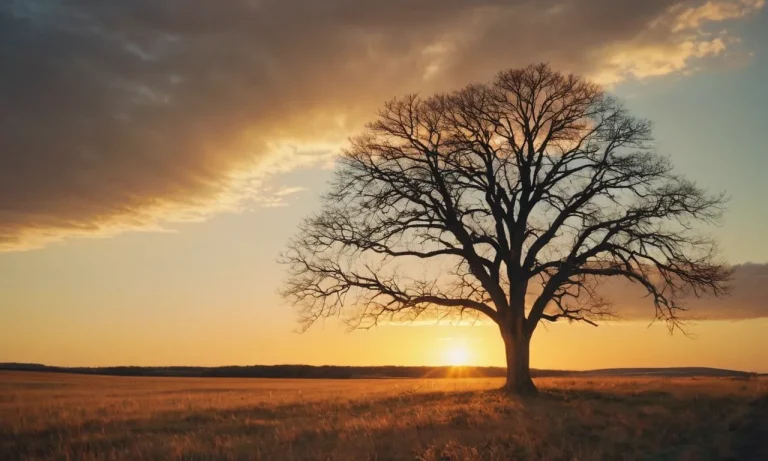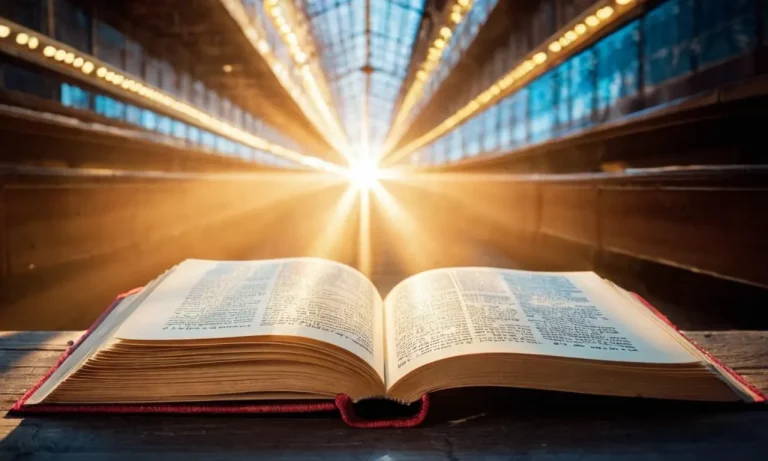The ginkgo leaf holds deep symbolic meaning in many cultures and spiritual belief systems throughout history. If you’re wondering what meaning and significance people have attached to this unique leaf over time, you’ll find an explanation here.
In brief, the distinctive fan-shaped ginkgo leaf is associated with concepts like longevity, vitality, endurance, hope, peace, unity, duality, and the life cycle.
Read on as we explore the extensive spiritual legacy behind the ginkgo biloba tree and its golden leaves.
The Ginkgo Leaf Shape and Its Meaning
The Fan Shape and Its Significance
The unique fan shape of the ginkgo leaf carries deep spiritual meaning and symbolism. Resembling an open fan fluttering in the breeze, the ginkgo leaf’s distinctive notched shape is imbued with significant cultural and religious connotations across Eastern societies.
In Chinese culture, the fan-shaped ginkgo leaf symbolizes longevity, endurance, and resilience. Its ability to thrive through adversity is viewed as a sign of strength and vitality. According to Taoist philosophy, the ginkgo’s distinctive leaf shape also represents the concept of yin-yang – the interaction between opposing yet complementary forces that bring balance and harmony.
In Buddhism, the ginkgo leaf is seen as a manifestation of enlightenment and the openness of the mind to wisdom and truth. Its radiating veins and fan-like form evoke the image of rays of light emanating from the Buddha or a holy person who has attained spiritual awakening.
The notches along the edge of the leaf are also viewed as symbolic of the challenging yet ultimately rewarding path towards nirvana or inner peace.
Moreover, in Japanese culture the ginkgo leaf carries connotations of blessing, nobility, and longevity due to the tree’s long life span. Its use as a heraldic symbol among Japanese samurai families reflected a wish for health, prosperity, and divine favour, which the distinctive leaf shape seemed to promise.
Across Asia, artists and poets have long used ginkgo leaf imagery when conveying themes related to the duality of adversity and vitality, enlightenment emerging from worldly struggles, and the radiating wisdom gathered over a long virtuous life.
Its vibrant yet delicate form makes it a powerful living symbol infused with spiritual meaning.
Duality and Yin-Yang Represented
The ginkgo leaf wonderfully embodies the concept of yin-yang through its very shape and structure. Its fan-like form with notches and veins radiating from a central point beautifully symbolizes the Taoist notion that all things contain opposing yet symbiotic forces.
The solid characteristic of the leaf represents the yin essence – dark, passive, feminine, and contracting. The more delicate veined texture that allows light through embodies the yang characteristic – bright, forceful, masculine, and expanding.
Yet the leaf is one unified structure, even as it exemplifies mutually balancing dualities working together in harmony.
This interplay between solidity and openness within the ginkgo leaf echoes the ebb and flow between dual forces that ultimately allows energy to circulate and life to thrive. It reflects the waxing and waning cycles seen in nature – night turning to day, winter transforming into spring.
Without this dance between contrasting but complementary aspects, the vitality of the living world would become locked into stillness.
So in its form, veins, and notches – through rigid and yielding structures coexisting – the ginkgo leaf provides a vivid reminder to embrace opposing forces in life in order to find balance and wholeness.
Its long survival as a species further symbolizes the fruitfulness of this harmonious inner dance, allowing longevity and centering peace to bless one’s years.
Just as the ginkgo leaf models unity through duality, its enduring yet adaptable nature also conveys hope for weathering life’s difficulties and finding grace through the years. For this leaf both whispers ancient wisdom and offers a lesson in spiritual resilience dearly needed in turbulent times.
Association with Long Life, Vitality, and Endurance
Revered as a Living Fossil
The ginkgo is often revered as a “living fossil” because it is the sole surviving species of the ancient ginkgoales group, with fossils dating back 270 million years. As a species that has endured major extinction events when many other plant species died out, the ginkgo leaf has come to symbolize longevity, persistence, and resilience.
Ginkgos are extremely long-lived trees, with lifespans averaging 650-1,000 years. Some ancient ginkgo trees in China are estimated to be over 2,500 years old. The tenacity of this species to survive and thrive for millennia contributes to its spiritual meaning of vitality and endurance.
Traditional Uses for Health and Longevity
Ginkgo leaves and seeds have been used in traditional Chinese medicine for centuries to promote longevity, boost energy, and treat ailments. Compounds found in ginkgo leaves like terpenoids and flavonoids are believed to have potent antioxidant and anti-inflammatory effects that may help slow aging processes and protect cells from damage.
Modern research has validated some of these traditional health uses of ginkgo. Multiple clinical studies suggest ginkgo leaf extracts may enhance memory, concentration, vascular function and blood flow (especially for elderly populations), making it a popular herbal supplement today.
Symbol of Hope and Recovery
The ginkgo survived the 1945 atomic bombing of Hiroshima, even sprouting new leaves amidst the devastation. Today a surviving ginkgo tree near Hiroshima’s A-bomb epicenter has become known as the “bearer of hope” and is seen as a spiritual reminder of recovery and regeneration.
Ginkgo leaves featured on the emblem of the International Chernobyl Project represent vitality triumphing over adversity. The emblem commemorates recovery efforts in areas impacted by radioactive contamination from the 1986 Chernobyl disaster. Once again the ginkgo symbolizes resilience and hope.
| Ginkgo Trait | Spiritual Meaning |
|---|---|
| Longevity (some trees over 2,500 years old) | Endurance, longevity |
| Survived major extinction events when other species died off | Persistence, resilience, adaptability |
| Leaves and seeds used in TCM for energy and anti-aging effects | Vitality, health |
| Survived atomic bombing and Chernobyl disaster | Hope, regeneration after devastation |
With evidence of the ginkgo species spanning hundreds of millions of years into the deep past and individual ginkgo trees living for millennia, it’s easy to understand how this “living fossil” has gained spiritual meaning representing longevity, vitality, adaptability, and even optimism that life endures, heals, and persists through immense adversity.
Representing the Life Cycle and Seasons
The Annual Loss and Regrowth of Leaves
The ginkgo tree is deciduous, meaning it sheds all of its fan-shaped leaves each autumn before growing them back in spring. This annual cycle of leaf loss and regrowth holds deep symbolic meaning in many cultures, representing themes of change, renewal, and the cycle of life.
In Buddhism, the ginkgo leaf’s annual rebirth is viewed as a representation of reincarnation. As one set of leaves drops away, they fertilize the soil to nourish the next generation – a poetic mirror of the soul’s rebirth into a new body.
This meaning infuses the ginkgo leaf with a sense of peace and acceptance of the impermanent nature of life.
In Chinese culture, the timing of the ginkgo leaf growth and fall has long been used as a way to mark the changing of the seasons. Poets dating back to the Song Dynasty wrote verses referencing the bare ginkgo branches of winter and the lush greenery of summer.
To this day, the leaf motifs remain a symbol of seasonal change in much Chinese art and literature.
Across Japan, ginkgo trees line city streets and gardens as a living calendar, with tourists and locals alike tracking the wave of golden autumn foliage as it moves north each year. This phenomena even has a name – ichō namiki – translating to “ginkgo trees lining the street”.
The visual spectacle holds cultural significance as a reminder of life’s impermanent beauty.
Connotations of Change and Impermanence
Beyond the seasonal cycle, the ginkgo leaf’s symbolic meanings also encompass larger ideas around change and impermanence in life.
In Japanese culture, the singular notch in most ginkgo leaves is viewed as representing the imperfect nature of all things in life. Shinto rituals involved offering ginkgo branches at shrines, acknowledging that we must accept small flaws to see life’s larger beauty.
The ginkgo leaf is also an ancient Chinese Taoist symbol of change and evolution, beginning as a small sprout and growing into a full leaf with delicate veins. This representation reinforces the Taoist principles of embracing life’s transformations with patience and harmony.
No matter one’s cultural lens, the annual growth cycle of ginkgo trees serves as a living reminder to approach change with mindfulness and reverence. As a species that has thrived largely unchanged for 200 million years, the ginkgo itself embodies this spirit of calmly adapting to life’s seasons.
The Ginkgo as a Spiritual and Cultural Icon
Role in Eastern Philosophy and Feng Shui
The distinctive fan-shaped leaves and golden fall color of the Ginkgo have made it a revered element in Eastern philosophy and Feng Shui design for centuries. In Confucianism, the Ginkgo is seen as a symbol of wisdom, longevity, and respect.
In Daoism, the balanced forking of Ginkgo branches reflects the Yin and Yang dichotomy. And in Buddhism, Ginkgo trees are often planted near temples as they represent awakening and enlightenment.
In Feng Shui, the unique two-lobed leaf shape of the Ginkgo makes it a treasured icon. Feng Shui followers will often display dried Ginkgo leaves in homes or wear small Ginkgo leaf charms to represent the value of balancing our life priorities into harmonious halves.
The golden autumn Ginkgo color is also seen as uplifting, optimistic energy. No wonder Ginkgo motifs have been integrated into everything from ancient scroll paintings to modern architecture in the East!
Sacred Ginkgo Trees and Temple Sites
Given its ties to Eastern spirituality, it is no wonder that Asia is dotted with Ginkgo trees that hold special historical significance at temples, shrines, and other places of tranquility. One sacred Ginkgo site is the Gu Guanyin Buddhist Temple in China’s Zhejiang Province where a 1000+ year old tree rises elegantly near a bronze statue of Buddha.
Pilgrims often lay offerings at its base. Equally famous is the Ginkgo growing at the Tsurugaoka Hachimangū shrine in Kamakura, Japan which dates back 700+ years. Its bright canopy shades the Genpei Pond, drawing tourists and devotees who find peace in its presence.
In the West, the Ginkgo has also been embraced in sacred spaces, like the elegant 150 year old Ginkgo biloba growing at the National Cathedral in Washington D.C. During autumn, visitors flock to see its small green leaves transform into bright bursts of radiant gold – a uplifting sight for people of all beliefs.
Integration into Western Culture
Beyond landscapes and architecture, the Ginkgo leaf has become an iconic motif in the West as well over the past century, spreading awareness of its unique history and ties to the natural world. From the Ginkgo leaf in the logo for Prudential Financial to the Ginkgo leaf earrings trending on Etsy, its symbolism thrives in modern culture.
The Ginkgo has also been embraced as an emblem of hope and renewal in spaces like Hiroshima’s Peace Park in Japan where Ginkgo trees that survived the 1945 blast still grow. And its environmental hardiness makes it a staple urban tree, lined across avenues in major cities globally.
Wherever it spreads – either deliberately planted or self-seeded – its enduring, vibrant presence continues to inspire and fascinate.
Conclusion
The ginkgo leaf’s distinctive fan shape and annual cycle of regeneration has imbued it with diverse symbolic meanings across many spiritual traditions.
It represents longevity, vitality, unity, duality, peace, impermanence, and the resilience of life itself.
This ancient tree remains a living cultural treasure, its golden foliage continuing to inspire awe and reflection.






